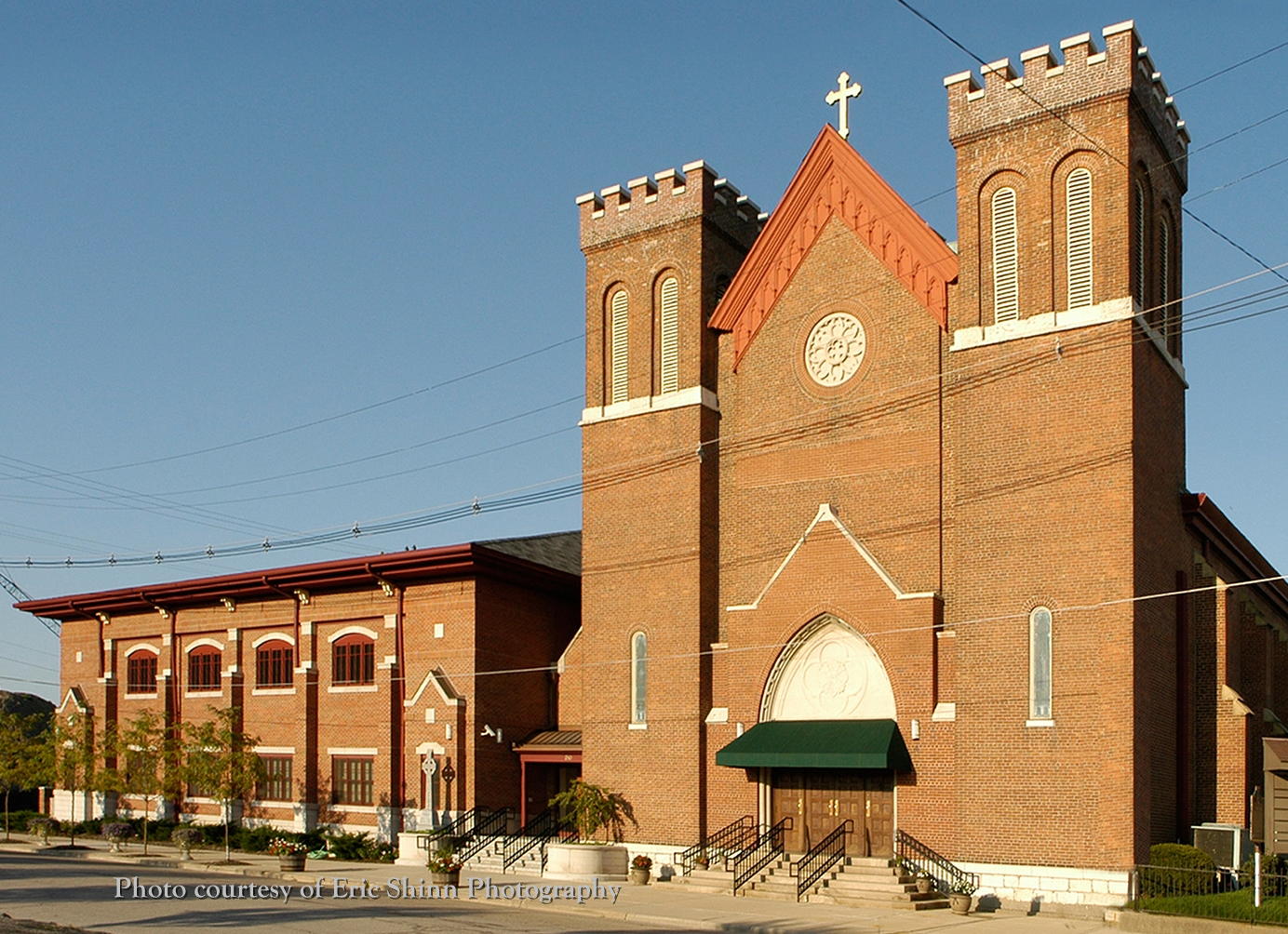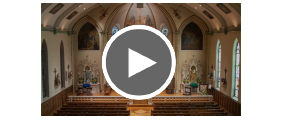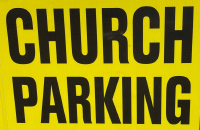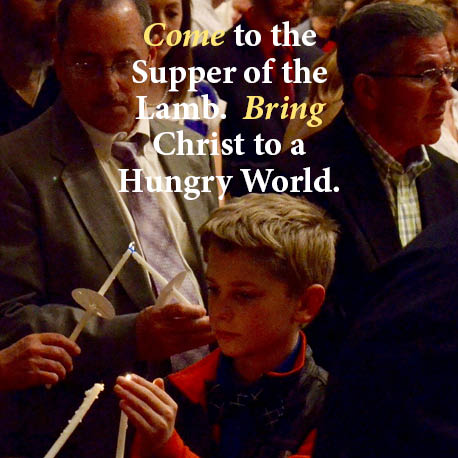St. Patrick Church is located on the corners of Naghten Street, Grant Avenue, and Mount Vernon Avenue. The church, rectory and new parish center are all built of an exterior red brick with sandstone ornamentation. St. Patrick Church was completely renovated from floor to ceiling in anticipation of its Sesquicentennial Celebration in 2003. The interior of the church contains a large vaulted ceiling in a simple Romanesque architectural style.
 The vestibule of the church contains shrines to St. Therese of Lisieux and the Infant of Prague , the usher's room, and the entrance stairway to the choir loft. Just above the main entrance of the church's interior is a cross-stitch tapestry of St. Patrick which was brought to Columbus by Irish immigrants in the 19th century. To the left of this tapestry is a reliquary which holds the major relics of Bl. Margaret's heart (which is venerated each Wednesday), a gold reliquary of numerous Dominican Saints, a relic of our Patron St. Patrick, and relics of St. Thomas Aquinas, St. Gianna Molla, and Blessed Pier Giorgio. Throughout the church there are candles available for invocation of the saints and prayer.
The vestibule of the church contains shrines to St. Therese of Lisieux and the Infant of Prague , the usher's room, and the entrance stairway to the choir loft. Just above the main entrance of the church's interior is a cross-stitch tapestry of St. Patrick which was brought to Columbus by Irish immigrants in the 19th century. To the left of this tapestry is a reliquary which holds the major relics of Bl. Margaret's heart (which is venerated each Wednesday), a gold reliquary of numerous Dominican Saints, a relic of our Patron St. Patrick, and relics of St. Thomas Aquinas, St. Gianna Molla, and Blessed Pier Giorgio. Throughout the church there are candles available for invocation of the saints and prayer.
To the left of the reliquary is the Shrine of Bl. Margaret of Castello. Her Guild was established here in 1935. The statue is carved from a solid piece of wood and depicts Margaret's handicaps, namely that she was blind and lame, walking with the support of a cane. The tapestry on the right hand wall depicts the life of our Little Margaret. The cross is made from the original church timbers burned in the 1935 fire and has been named the Cross of Sorrow. The banister newel post on the left hand wall of the shrine is from the stairway of the old St. Patrick School building that was razed to make room for the new parish center. It holds a relic of Bl. Margaret for personal veneration.
The beautiful wood floor is of red oak interspersed with occasional maple boards and surrounded by a discreet border of walnut. The inlaid shield of the Dominican Order of maple and walnut is a prominent feature adorning the space in front of the altar. The solid oak pews are carved with shamrocks. Confessionals on the north and south sides of the church match the wainscoting along the north, south, and west walls. Stations of the Cross encircle the body of the church.
Framed portraits of the saints look down upon the congregation. Beginning with the northeast corner and continuing to the southeast corner are St. Thomas Aquinas, St. Catherine of Siena, St. Antoninus, St. Agnes of Montepulciano, St. Vincent Ferrer, Bl. Pier Giorgio Frasatti, St. Gianna Molla, St. Hyacinth, St. Catherine de Ricci, Pope St. Pius V, St. Rose of Lima, and Our Holy Father Dominic. The large framed painting in the center of the ceiling depicts in the top panel the Coronation of the Blessed Virgin Mary, and in the bottom panel, the Apostles on earth, peering into the empty tomb which has miraculously sprouted fresh flowers. The painting over the Bl. Mother shrine depicts Our Lady giving the Holy Rosary to St. Dominic in the presence of the Christ Child. The painting over the St. Joseph shrine depicts Saints Joachim and Ann presenting their daughter, Mary, to God in the temple. Over the High Altar is the depiction of the crucifixion of Our Blessed Savior, along with the Blessed Mother, St. Mary Magdalene, and St. John.
The High Altar contains the tabernacle and was a gift of Bishop Hartley. (Altar trivia: If you look closely, you will find an extra hand at the supper table. By carefully matching arms, hands and bodies, it is apparent that the artist simply added an extra hand to make it “look right”, even though the hand does not belong to anyone at the table.) The Altar of Sacrifice was installed in 2003 and contains a beautiful reliquary of mostly Dominican saints. The wrought iron pulpit was installed in 1937 and contains the crests of the Diocese of Columbus, the Dominican Order, and the Dominican Province of St. Joseph.
The stained glass windows beginning with the northeast corner and continuing to the southeast corner depict the Last Supper of Jesus and the Apostles, The Annunciation, Saint Margaret Mary Alocoque, The Wedding Feast at Cana, St. Patrick, The Dominican Shield, Saints Vincent de Paul and Anthony of Padua, St. Thomas Aquinas, St. Mary Magdalene, The Death of St. Joseph, The Resurrection, and the Presentation of Jesus in the Temple.
To the left of the main altar is The Shrine of Our Lady of the Immaculate Conception which holds smaller statues of St. Mary Magdalene, patroness of penitents and protectress of the Dominican Order, and St. Dominic. The Shrine of St. Joseph and the Child Jesus to the right of the main altar holds smaller statues of St. Patrick and St. Michael the Archangel.
Separating the sanctuary from the main body of the church is a beautiful altar rail which is still in use today. To the left of the main sanctuary is the Priest sacristy, and to the right is the Altar Boy sacristy. The doors to these sacristies have Tiffany stained glass depicting angels adoring before the Blessed Sacrament. The Bl. Margaret Shrine and the communion rail kneeling pads are handmade cross-stitch tapestry. This beautiful and intricate artwork was done by members of the Women's Club.
The bell tower is located above the Shrine of Bl. Margaret. There are three automated bells that were dedicated on the 8th of August 2003. They are named S.P.N. Dominicus—Our Holy Father Dominic (1,100 lbs), Mater Ecclesia—Mother of the Church (690 lbs.), and S.P. Franciscus—Holy Father Francis (455 lbs.). The bells ring the Angelus three times a day, five minutes before each weekend Mass, and other occasions as well.
In the space that joins our church to the new parish center, a baptistery full of light and sacred space welcomes the newest members of the church and reminds those already baptized of their new life in Christ. The baptismal font is carved from Alabama limestone and weighs 2.5 tons. It is modeled after a 12th Century baptismal font at the church where St. Dominic served as an apprentice to his uncle who was a parish priest. The Baptismal gallery or atrium also houses shrines to our Lady, the Sacred Heart, and our patron, St. Patrick. The circular window carries the Greek monogram for Jesus Christ. Down the courtyard corridor is a separate alcove shrine to St. Joseph. The newly constructed parish center houses parish offices, offices for pastoral staff, a conference room, parish library, two large banquet halls, lavatories, classrooms, and meeting rooms.




 The vestibule of the church contains shrines to St. Therese of Lisieux and the Infant of Prague , the usher's room, and the entrance stairway to the choir loft. Just above the main entrance of the church's interior is a cross-stitch tapestry of St. Patrick which was brought to Columbus by Irish immigrants in the 19th century. To the left of this tapestry is a reliquary which holds the major relics of Bl. Margaret's heart (which is venerated each Wednesday), a gold reliquary of numerous Dominican Saints, a relic of our Patron St. Patrick, and relics of St. Thomas Aquinas, St. Gianna Molla, and Blessed Pier Giorgio. Throughout the church there are candles available for invocation of the saints and prayer.
The vestibule of the church contains shrines to St. Therese of Lisieux and the Infant of Prague , the usher's room, and the entrance stairway to the choir loft. Just above the main entrance of the church's interior is a cross-stitch tapestry of St. Patrick which was brought to Columbus by Irish immigrants in the 19th century. To the left of this tapestry is a reliquary which holds the major relics of Bl. Margaret's heart (which is venerated each Wednesday), a gold reliquary of numerous Dominican Saints, a relic of our Patron St. Patrick, and relics of St. Thomas Aquinas, St. Gianna Molla, and Blessed Pier Giorgio. Throughout the church there are candles available for invocation of the saints and prayer.